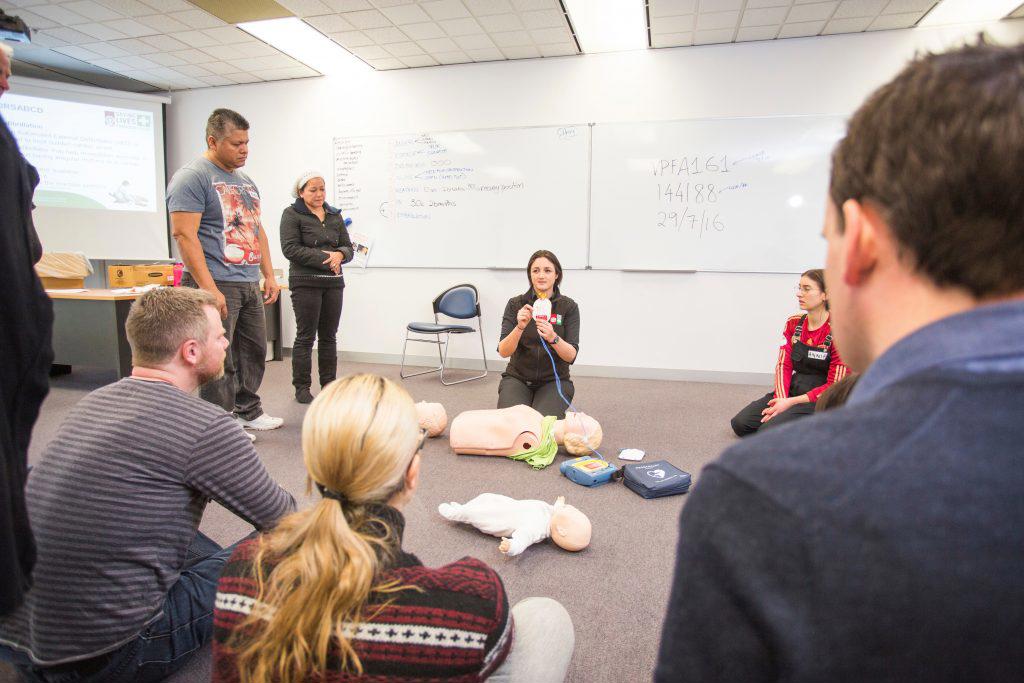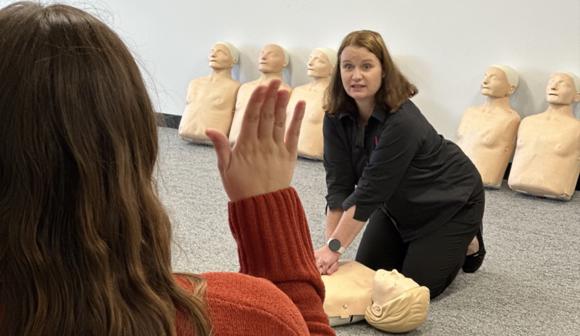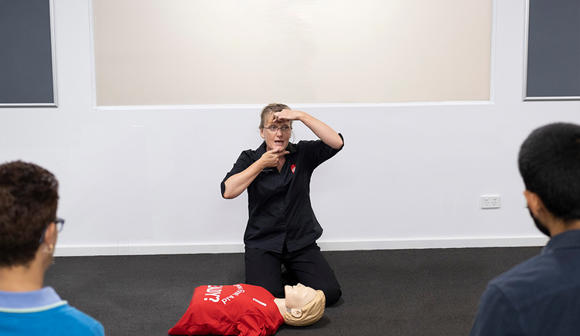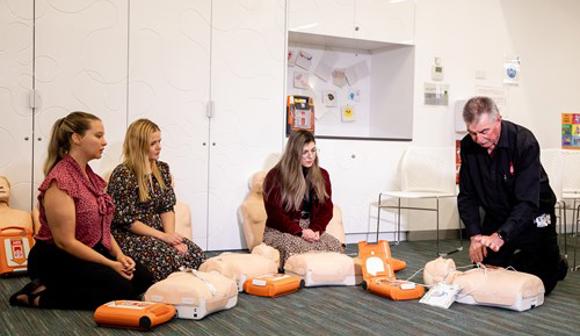What Really Happens At A First Aid Course

So, your workplace has advised you need to complete a First Aid course? Or you’re a parent and want to ensure you can provide immediate assistance to your child in the case of an emergency? Or maybe you donate your time at your local community club and the need for First Aid has become apparent?
There are many reasons why people decide to undertake First Aid training. After all, the need for First Aid does not discriminate. No matter what your age, sex or family history an emergency can occur to anyone, at any time in any environment. Whether that’s choking on a meal, an asthma attack, an insect bite, anaphylactic shock or even sudden cardiac arrest, there is the strong possibility of all of us experiencing a First Aid incident anywhere we go.
But if you’re someone who has never completed First Aid training before you might be wondering ‘What really happens at a First Aid course?’ The answer is you learn the skills required to provide lifesaving First Aid, and here is how.
How To Prepare For Your First Aid Course
Some First Aid courses may require you to complete pre-reading before the course date. It’s important you complete this as it features critical First Aid information that you will be required to know throughout your course.
If you don’t have any set pre-reading there is nothing you need to do prior to your First Aid course. It is recommended that you do NOT undertake any research about First Aid before your course as you might find incorrect or outdated information which is likely to cause confusion throughout the course.
It is recommended you set up your Unique Student Identifier (USI) prior to your First Aid course but this is not a requirement. Learn how to set up your USI here.
What To Wear To Your First Aid Course
It’s advised all participants wear comfortable clothing that allows freedom of movement. First Aid courses involve many practical demonstrations which may require you to get onto your knees or down on the floor.
What To Bring To Your First Aid Course
There is a lot of content to be covered in a First Aid course so it’s always best to come prepared to ensure you’ll be ready for a full day of learning. Key items you should always bring to a First Aid course include:
- A notebook to write down all the First Aid notes you need
- A pen or pencil for your notes
- A water bottle
- Lunch and snacks. Or if you have done your research and know there are cafés located nearby ensure you bring cash to buy your coffee, lunch or snacks.
About First Aid Trainers
First Aid training is taught by trained professionals who often have a history of working in the medical and health industry. In addition to this, at St John, many of our trainers are long-term event First Aiders. This expert knowledge and real-life experience allows First Aid trainers to provide incomparably valuable insight to their students.
Learning First Aid
Learn WHAT To Do
First Aid courses include both theory and practical demonstration of possible First Aid scenarios. First Aid situations require specific steps that must be followed to ensure the casualty is treated with optimum care at all times and to avoid causing any further damage.
Every First Aid topic has a unique First Aid approach. The combination of theoretical and practical training and assessment allows students to relate the information to real life events and recall the information easily. This is why nationally accredited courses must be completed in person and not online.

Learn WHEN to do it
DRSABCD
A First Aid incident should be approached with caution and appropriate First Aid steps should be completed in the same order every time.
A commonly known First Aid acronym is DRSABCD. This is called the ‘Action Plan’ and it ensures that the responder’s safety is always a priority. It also guarantees that the casualty will receive the necessary First Aid assistance in the correct sequence to ensure they have the best chance of survival. As an example, performing CPR before checking breathing could result in unnecessary harm if the casualty is, in fact, breathing correctly.
To learn more about DRSABCD click here.

It is important that someone is able to differentiate what the injury or medical emergency is and the severity of it. Completing a course means the individual will be able to notice the difference between First Aid situations that an untrained person may not be able to. This provides a greater sense of control and calm over the situation to the casualty, their friends or family and any other bystanders, which can save precious time in the treatment response.
An untrained person may not be able to determine the difference between a sprain, a strain, a fracture or a break. First Aid courses cover each topic thoroughly to ensure students have the knowledge required to asses First Aid situations and identify what the injury or medical emergency may be. This is an important skill as the First Aid procedure may vary per injury or medical emergency.
Learn When a First Aider Should Respond Or Wait For Medical Assistance
There may be emergencies where a First Aider is not able to respond due to the seriousness of the injury or medical emergency. First Aid training teaches you the skills required to decipher when the injury or medical emergency is outside of your training and it is necessary to wait for medical assistance.
Important note: First Aiders will only be able to respond and provide assistance to injuries or medical emergencies within their training.
Learn HOW to do it
Real Life Scenarios
St John Ambulance Victoria’s courses are run by trained professionals who are experts in First Aid. Our trainers have real life knowledge and are able to apply their experience to their teachings. By providing knowledge from real life situations it enables students to learn through a more in-depth, engaging and relevant approach.
Theory
Every First Aid course will include theoretical information on First Aid. Your trainer will explain need-to-know information on each topic before presenting any practical demonstrations.
Practical Demonstrations
Practical demonstrations are used to apply the theoretical First Aid information taught. The hands-on approach allows trainers to engage students and demonstrate First Aid scenarios in a way that is applicable to their environments.
Throughout your First Aid course, you will partner with other students to apply the theory you have learnt. As an example, you will not only be shown how to apply a bandage for a puncture wound, you will practice your newly learnt skill on your partner. Your First Aid trainer will assist and provide feedback to ensure your knowledge and application of a bandage for a puncture wound is up to First Aid standards.
There will be many practical elements throughout your First Aid course. These include running through the DRSABCD action plan, positioning your partner into the recovery position, applying a St John sling to your partner and many more.
The practical element of First Aid courses is designed to build and instil confidence in First Aiders so when they are needed they can respond with certainty. The first few moments of a First Aid event can be critical so by building the confidence of our First Aid students we are increasing the possibility of a casualty receiving the First Aid they need within the timeframe they need it.
Assessment
For each individual practical demonstration completed with your partner, your First Aid trainer will mark whether or not you have acquired the skills to apply First Aid for that scenario. The practical assessments give students the opportunity to put the skills and knowledge developed throughout their training into practice.
At the end of your St John Ambulance Victoria Provide First Aid (HLTAID003) course, you will complete a multiple-choice test which will examine your First Aid knowledge. The test consists of 38 questions based on the information taught throughout your course and you must score a minimum of 30 (80%) to pass your First Aid course.
What You Will Get Out Of A First Aid Course
- Knowledge, skills and confidence to respond and provide First Aid
- The skills to identify and assess the nature of an injury or illness within your training
- A thorough understanding of the First Aid Action plan, DRSABCD that guides all First Aid incidents
- Ability to identify and prevent potential First Aid hazards
- A thorough understanding of when it is appropriate to provide First Aid
- Knowledge of what NOT to do in a First Aid situation
First Aid courses are designed to provide students with the skills necessary to provide assistance until medical help arrives. In an emergency, the initial moments can be critical so it’s important that environments such as workplaces, community clubs and public events have trained First Aiders onsite at all times.
First Aid knowledge is relevant in all scenarios ranging from minor injuries through to critical medical emergencies. Once completing your First Aid course and assessment you will have the confidence and skills to respond to a First Aid event no matter where you are, who you are with or how serious the incident is.
First Aid knowledge is an instrumental skill and by increasing the number of Victorians who can provide First Aid at every local sporting event, shopping centre, workplace and your family home, the communities’ resilience will prosper.

HLTAID011 PROVIDE FIRST AID
Suitable for both people in workplaces and members of the public who would like a comprehensive first aid course.

HLTAID009 PROVIDE CARDIOPULMONARY RESUSCITATION
Learn the skills to perform life-saving (CPR) on an adult, child or infant who is unconscious and not breathing normally.

VENUES & LOCATIONS
St John has a range of training locations across Victoria.
